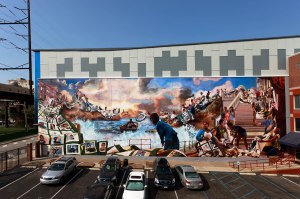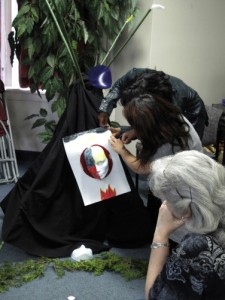Blog by Sarah Jeavons Wright, originally posted in February 2019 during her time as Research Fellow on the Wellcome Trust/University of Edinburgh ISSF funded pilot project.

Image by Pexals via Pixaby https://pixabay.com/photos/art-watercolors-arts-and-crafts-1851483/
‘It has become increasingly clear since the latter half of the 20th century that knowledge or understanding is not always reducible to language… Thus not only does knowledge come in different forms, the forms of its creation differ’
(Eisner, 2008: 5).
As mentioned in our last blog (Language and the Meaning of Suicide), a key component of the ‘Suicide Cultures’ project is to run arts-based workshops with community groups in Scotland, offering people the opportunity to explore and express their feelings and views about suicide through the act of making and creating, be it drawings, paintings, clay forms, collage or writing stories. Guided by existing evidence which suggests art can help us to get to a place of deeper understanding (Tarr et al 2018), we hope that the ‘Suicide Cultures’ arts-based workshops will enable meaningful exploration, in a co-designed supportive environment, of understandings of suicide that go beyond both rational/cognitive ways of knowing (Vaart et al 2018; Foster 2015).
Arts-based research methods, which incorporate many different approaches (such as those listed above, as well as others including poetry, dance and theatre), centre around the principle of disrupting the power imbalance between researcher and research participant. Informed and shaped by feminist approaches to research, and de-colonising methodologies, arts-based methods strive to challenge normative constructs of ‘data collection’ and research ‘subjects’, and, instead, build new principles of research ‘collaborators’ and the materials generated as participant, or ‘collaborator, produced’ objects (Mannay 2015: 22). Put simply, arts-based methods seek to ‘democratise, and enliven, both process and product of qualitative research’ (Horsfall and Titchen 2009: 147).
Arts-based methods in the study of suicide
Arts-based methods, with their focus on non-verbal means of communication, allow for explorations of meaning that exist both within, and beyond, language. Consequently, such methods can be particularly useful when researching experiences and views of sensitive or taboo issues (Gameiro et al 2018). Yet, while the creative arts therapies have been used to address emotions related to, and surrounding, suicide, there remains a dearth of projects which use arts-based methods in order to gain understandings of suicide and promote suicide awareness (Silverman et al 2013). Yet, there are a few projects which have explored the possibilities of arts-based approaches to create what Tarr et al (2018) refer to as an ‘improvisatonal space’ that allows for suicide to be explored in a new way, collectively and creatively. Torres and Warr used drawing and photography as a means to examining the socio-political context of suicide among young people in Chile – an approach which offered ‘open-ended, non-threatening and emotionally supportive strategies for exploring the topic’, during interviews (2016: 144). The ‘Finding the Light Within’ project – a collaboration between Mural Arts Philadelphia, the Department of Behavioral Health and Intellectual disAbility Services, and the American Foundation for Suicide Prevention – used community mural making (see photo 1 below) as a means through which to shed light on youth suicide in the community by ‘providing a voice for survivors, attempters, and their families and friends by creating a new community around the issue’ (Mural Arts Philadelphia, n.d). Finally, through drama, music, art-making and writing, Silverman et al (2013) brought a diverse and multicultural collective together over the course of two days in order to explore the complexity of feelings and perspectives associated with suicide among the group (see photo 2 below). Similar to the other studies mentioned, Silverman et al saw arts-based methods as a way to give participants ‘a sense of safety and of distance that allowed them to address difficult and deeply private topic’ (2016: 220). Situating our own project within this small body of research, it is our hope that the ‘Suicide Cultures’ art workshops will contribute to understandings of suicide as complex, situated and inter-personally mediated.
1-
Photo by Steve Weinik – Finding the Light Within.
2-

Jenna Dawn MacLellan – ‘Coming together in Joy and Pain’
Interpreting art
‘Beyond their making, images themselves are constantly subject to interpretation and re-interpretation … and all readings employ forms of creative analysis’
(Mannay 2015: 1-2).
The art workshops will be generative spaces where different meanings can emerge and co-exist, interwoven with and informing each other. As a result, it is vital to understand that the works created in the workshops are ‘’lively’ in the sense that they are context-dependent, improvisational and one-of’ (Tarr et al 2018: 48). So, when it comes to interpreting the art works, we must always remain mindful that these objects are not claims of ‘authentic’ truths, but are instead artefacts of a moment and representation that might, indeed, change (Tarr et al 2018; Foster 2015). Put simply, the art works produced in the workshops carry important messages and meaning, from a specific, dynamic and interpersonal time and space.
……………
Eisner, E., 2008. Art and knowledge. Handbook of the arts in qualitative research, pp.3-12.
Foster, V., 2015. Collaborative arts-based research for social justice. Routledge.
Horsfall, D. and Titchen, A., 2009. Disrupting edges–opening spaces: pursuing democracy and human flourishing through creative methodologies. International Journal of Social Research Methodology, 12(2), pp.147-160.
Mannay, D., 2015. Visual, narrative and creative research methods: application, reflection and ethics. Routledge.
Mural Arts Philadelphia. (n.d.). Finding the Light Within – Mural Arts Philadelphia. [online] Available at: https://www.muralarts.org/artworks/finding-the-light-within/ [Accessed 21 Feb. 2019].
Silverman, Y., Smith, F. and Burns, M., 2013. Coming together in pain and joy: A multicultural and arts-based suicide awareness project. The Arts in Psychotherapy, 40(2), pp.216-223.
Tarr, J., Gonzalez-Polledo, E. and Cornish, F., 2018. On liveness: using arts workshops as a research method. Qualitative Research, 18(1), pp.36-52.
Torres, J.R.F. and Warr, D., 2016. Using Visual Research Methods to Explore First-Person Accounts of Suicide Behavior.
Vaart, G.V.D., Hoven, B.V. and Huigen, P.P., 2018. Creative and Arts-Based Research Methods in Academic Research: Lessons from a Participatory Research Project in the Netherlands. In Forum Qualitative Sozialforschung/Forum: Qualitative Social Research (Vol. 19, No. 2, p. 30). DEU.



laura
Hi, I’m undertaking a PhD exploring communication of suicidal distress in adolescent, using narrative interviews with both the young person and someone in their relational network, as agreed in collaboration with the intial participant. There is an arts-based element to the research where I co-produce a visual installation to let people know how better to attune to suicidal communication, and attend to what is said/done. I love what you’re doing and would like to know more if possible?
achandle
Hi Laura – that sounds like a fascinating project! Would love to hear more about it too 🙂 Can you email me and I will add you to our mailing list, and can also follow up with you for a chat so we can both learn more – a.chandler@ed.ac.uk